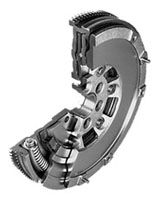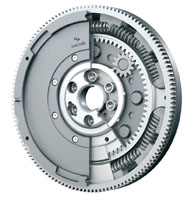What is a Dual Mass
Flywheel?
|
|
A
Dual Mass Flywheel (DMF) is a type of flywheel where the rotating mass
is split between two independent pieces. These two plates are joined by
a damping mechanism to dampen torsional spikes and vibration generated
through the crankshaft. This allows for a smoother and more enjoyable
driving experience. They generally work well as long as the engine remains
unmodified and the vehicle is not used beyond manufacturer's recommendations.
As soon as you start to increase the engine power over stock, or load
the vehicle or a trailer beyond the vehicle design specifications, overloading
will occur.
|
 |
|
Dual mass flywheels are tuned to match the engine torque curve, engine
resonant vibration characteristics, and vehicle load curves. They work
by having a set of springs inserted between two rotating masses (i.e.
Dual Mass). The springs are designed to absorb the resonant vibration
from the engine before it transfers to the transmission. The dual mass
flywheel contains an excessive "Friction Torque Limiter" so
that if the flywheel is suddenly overloaded, it is designed to start slipping
rather than damage the springs. This works fine as an occasional safety
valve, but if occurs too often, it can overheat and burn up. Dual Mass
Flywheels are not a good fit if the vehicle is overloaded, exceeds towing
limits, or the engine is modified to produce increased horse power over
the OE Specifications.
|
|
Dual mass flywheels are designed to provide maximum isolation of the frequency
below the engine's operating RPM, usually between 200-400 RPM. They are
also most effective during engine startup and shutdown.
|
| |
 |
| A
typical dual mass flywheel consists of 5 components: |
1. Primary Flywheel
2. Secondary flywheel
3. Arc Damper Spring
4. Friction Torque Limiter
5. Ring Gear
|
| |
When to consider converting to a Solid (Single Mass) Flywheel:
|
If
you have modified your engine and it generates more torque and horsepower
than the Original factory specs or if you intend to exceed the towing
limit of your vehicle, converting to a solid flywheel is required for
you to experience satisfactory clutch life. Once you have converted to a solid flywheel, the next time you need to
replace the clutch, the flywheel is simply resurfaced which will save
you money.
Please note that the original clutch is not compatible with the new solid
flywheel. So converting to a solid flywheel will require a complete Solid
Flywheel Conversion Clutch Kit consisting of the Pressure Plate, Clutch
Disc, Release Bearing, Pilot Bearing or Bushing, Alignment tool, Solid
flywheel, and bolts for the both the pressure plate and flywheel.
A Solid Single Mass Flywheel does tend to transmit more engine vibration
through the drivetrain and may seem a bit noisier in diesel engine pickups.
This noise is attributed to Transmission "Gear Rattle"
that only occurs with the vehicle is at rest and in neutral with the pedal up. As per the OE clutch manufacturer's analysis, this rattle noise does not shorten the life of any of the drivetrain components.
Solid Flywheel Conversions have been installed many thousands of times
all over the world in all types of vehicles with great customer satisfaction.
Related: Dual Mass Flywheel Bulletin, Dual Mass Flywheel Diagnostics Guide
|
|
|
|